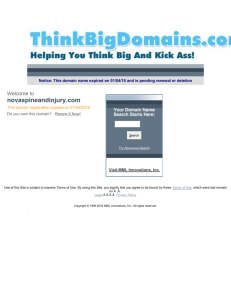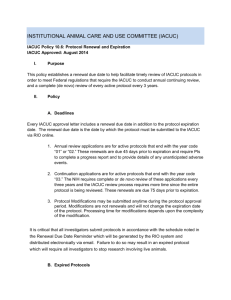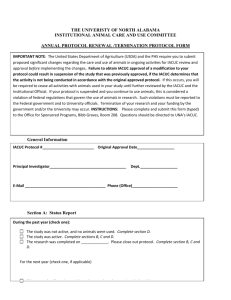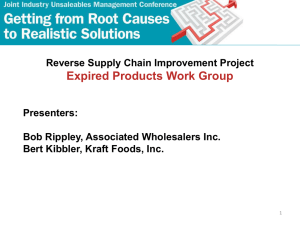Expired Drugs and Materials for Animal Research
advertisement
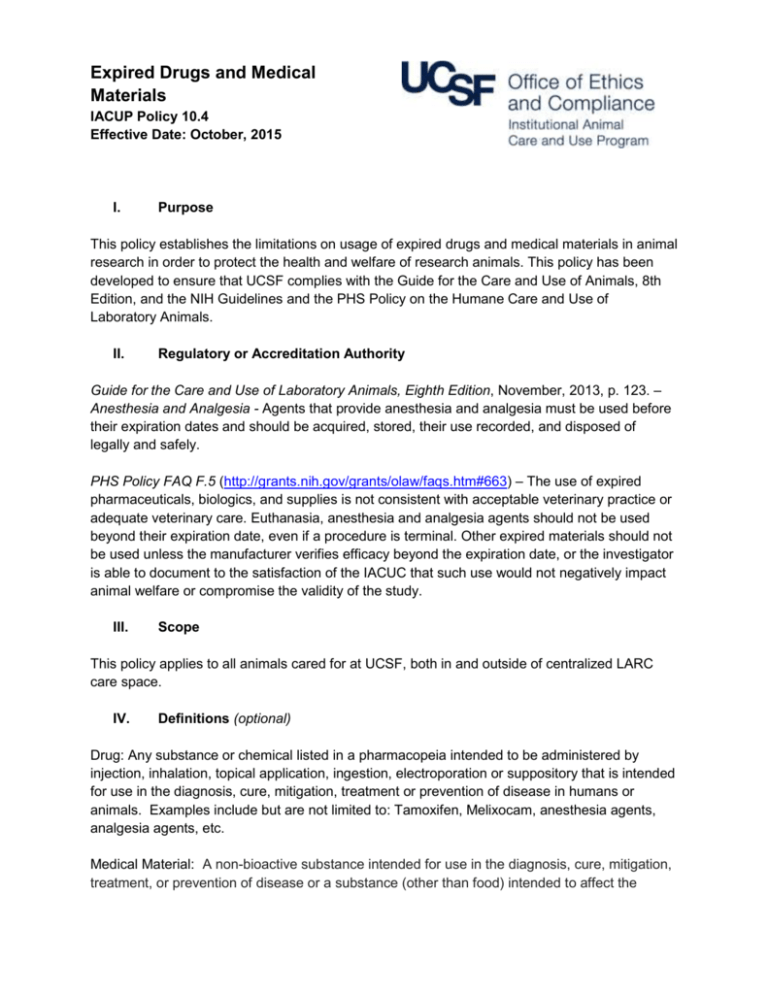
Expired Drugs and Medical Materials IACUP Policy 10.4 Effective Date: October, 2015 I. Purpose This policy establishes the limitations on usage of expired drugs and medical materials in animal research in order to protect the health and welfare of research animals. This policy has been developed to ensure that UCSF complies with the Guide for the Care and Use of Animals, 8th Edition, and the NIH Guidelines and the PHS Policy on the Humane Care and Use of Laboratory Animals. II. Regulatory or Accreditation Authority Guide for the Care and Use of Laboratory Animals, Eighth Edition, November, 2013, p. 123. – Anesthesia and Analgesia - Agents that provide anesthesia and analgesia must be used before their expiration dates and should be acquired, stored, their use recorded, and disposed of legally and safely. PHS Policy FAQ F.5 (http://grants.nih.gov/grants/olaw/faqs.htm#663) – The use of expired pharmaceuticals, biologics, and supplies is not consistent with acceptable veterinary practice or adequate veterinary care. Euthanasia, anesthesia and analgesia agents should not be used beyond their expiration date, even if a procedure is terminal. Other expired materials should not be used unless the manufacturer verifies efficacy beyond the expiration date, or the investigator is able to document to the satisfaction of the IACUC that such use would not negatively impact animal welfare or compromise the validity of the study. III. Scope This policy applies to all animals cared for at UCSF, both in and outside of centralized LARC care space. IV. Definitions (optional) Drug: Any substance or chemical listed in a pharmacopeia intended to be administered by injection, inhalation, topical application, ingestion, electroporation or suppository that is intended for use in the diagnosis, cure, mitigation, treatment or prevention of disease in humans or animals. Examples include but are not limited to: Tamoxifen, Melixocam, anesthesia agents, analgesia agents, etc. Medical Material: A non-bioactive substance intended for use in the diagnosis, cure, mitigation, treatment, or prevention of disease or a substance (other than food) intended to affect the structure or any function of the body. Examples include but are not limited to: gauze, sutures, catheters, etc. V. Policy A. Expired Drugs All drugs must be discarded on or before the manufacturer’s expiration date. No expired drugs or fluids are allowed for use on animals in research or instruction. All dilutions and mixtures of drugs are to be discarded after one month from the date of preparation unless a longer dilution shelf-life is specified by the manufacturer. Dilutions and mixtures of drugs may change the chemical composition of a drug and could alter its shelf life. For this reason, even if it is earlier than the manufacturer’s drug expiration date, all dilutions or mixtures made from a drug must be discarded after one month. B. Expired Medical Materials No expired medical materials or devices may be used beyond their expiration date; they must be separated from other materials and discarded. The one exception for use of expired medical materials is in acute terminal procedures. This exception requires specific IACU approval (see Appendix A). This includes medical-materials outside of their sterility date. Expired materials capable of being re-sterilized should be dated with a new expiration date appropriate for the package being used. IACUC Appendices for Expired Drugs and Medical Materials Appendices are provided as IACUC suggestions or recommendations. Deviation from the attached appendices may require IACUC approval. Appendix A: Expired Medical Materials Exception IACUC Approved: January 2009 Under some circumstances, the IACUC may approve a request to use expired medical materials and/or medical devices in acute terminal procedures only. If investigators wish to seek an exception to this policy, the Request to Use Expired Medical Materials or Devices in Acute Terminal Procedures in Animals used in Research or Instruction must be submitted to and approved by the IACUC. In addition to submission of the form, the IACU also requires the following: The Principal Investigator is responsible for making sure that an effective system is in place and that regular monthly audits of the inventory are performed. Investigators must read and complete all sections of the form Request to Use Expired Medical Materials or Devices in Acute Terminal Procedures in Animals used in Research or Instruction. This form includes a section to provide the justification for such a use, a description of the use, a plan for how sterility will be assured, and procedures for appropriately labeling and storing these materials separately from non-expired materials. A separate request form must be completed for each protocol. The PI must identify a segregated space where the expired medical materials and/or devices will be kept (e.g., a closet, a cabinet, a shelf). The segregated area must be clearly labeled with a label available from the IACUC Office which reads “Expired Medical Materials: For Use in Terminal Procedures Only.” The PI must identify a specific person who will be responsible for monitoring the inventory and making sure that each expired item is appropriately labeled with a red label available from AWAP which reads “Expired Medical Materials: For Use in Terminal Procedures Only.” Once approved, a signed copy of the Request form must be kept on file in section # 1 of the LARC/IACUC Logbook. From then on, the request form must be submitted in conjunction with the associated protocol renewal application and will be reconsidered on an annual basis. All authorized personnel must be informed of this request and trained in the proper procedures for using the expired materials or devices identified in the form. Appendix B: IACUC Recommendations IACUC Approved: January 2009 The IACUC recommends that each laboratory establish an inventory procedure to facilitate the identification and discarding of expired drugs. All medical materials and supplies used in live animals, including acute procedures, should be individually labeled. If items are not individually labeled, they must be kept in a drawer, bin, cabinet or other container clearly labeled with the PI’s name. The LARC area supervisor in LARC shared procedures rooms, or the Principal Investigator for all other shared-use laboratories, shall be authorized to discard materials which cannot be clearly identified by owner, whether or not they have reached their expiration date. EH&S will be contacted to arrange for disposal of unidentifiable contents. The following are general guidelines suggested to help comply with this policy: 1. Store all drugs in one location (to make checking easier). Please contact LARC if you would like assistance in obtaining a lockable box for your drugs. 2. Consider assigning the inventory responsibilities to one specific individual, with another individual assigned as backup. 3. Establish an inventory system which minimizes the amount of drug or medical supplies on hand. 4. Perform regular monthly checks of your inventory and discard all expired drugs or medical materials. 5. Contact your suppliers to see if they will accept the return of some expired drugs or medical supplies for credit. Some do. 6. Place all expired drugs and medical materials in a clearly labeled container while they await pickup for disposal or return to manufacturer. Appendix C: Disposal IACUC Approved: January 2009 Disposal services for expired drugs and/or controlled substances are available at no cost to the investigator by calling EH&S at 415-476-0544.

